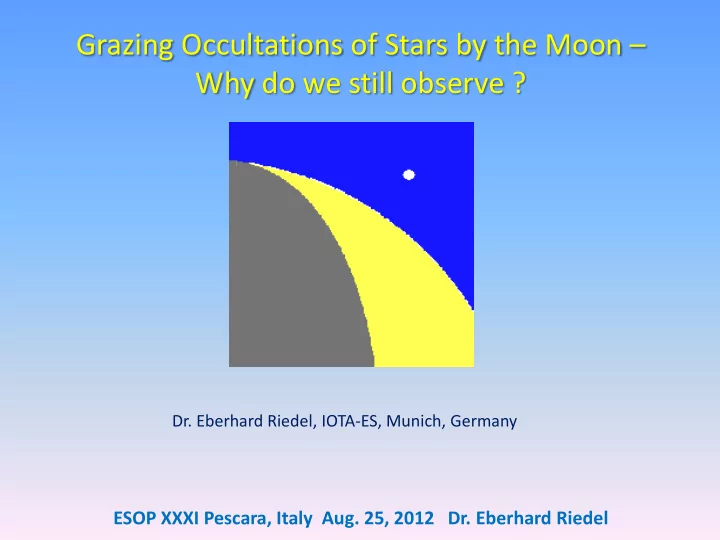

Grazing Occultations of Stars by the Moon – Why do we still observe ? Dr. Eberhard Riedel, IOTA-ES, Munich, Germany ESOP XXXI Pescara, Italy Aug. 25, 2012 Dr. Eberhard Riedel
Grazing Occultations of Stars by the Moon 1. The scientific purpose: • The purpose did change over the decades • Improving stellar positions until HIPPARCOS • Improving the lunar limb profile data until Kaguya • And now: Still improving lunar limb data ?? • Precise limb needed for solar diameter measurements • Finding errors in HIPPARCOS proper motions • Measuring stellar diameters • Training observational skills: • Prepare for different occultation observations • Total control over the equipment • Gaining experience in group observation organization ESOP XXXI Pescara, Italy Aug. 25, 2012 Dr. Eberhard Riedel
Grazing Occultations of Stars by the Moon 1. The scientific purose: • Grazing occultations reveal the mechanics of the solar system • Occultation timings reveal errors in stellar proper motions in the Hipparcos Catalogue • Overall rotational errors of the Hipparcos reference frame are assumed • The ‚Gaia‘ project of the ESA starting 2012 will measure 1 billion stars down to 1 μ “ !! ESOP XXXI Pescara, Italy Aug. 25, 2012 Dr. Eberhard Riedel
Grazing Occultations of Stars by the Moon 1. The scientific purpose: Why do we observe? • Baily‘s Beads reveal a variable solar diameter ESOP XXXI Pescara, Italy Aug. 25, 2012 Dr. Eberhard Riedel
Grazing Occultations of Stars by the Moon 1. The scientific purpose: Why do we observe? • Baily‘s Beads reveal a variable solar diameter • Reductions of Baily‘s Beads suggest a variable solar diameter of +/- 400 km • More ‚grazing occultation‘ observations of the sun are needed ESOP XXXI Pescara, Italy Aug. 25, 2012 Dr. Eberhard Riedel
Grazing Occultations of Stars by the Moon ESOP XXXI Pescara, Italy Aug. 25, 2012 Dr. Eberhard Riedel
Grazing Occultations of Stars by the Moon 2. Limb data improvement? Kaguya vs. Earthbound • How precise can earthbound observations be ? • Kaguya Laser Ranging Precision 5 to 200 meters • Average lunar velocity: 0.55“ (1,03 km) in 1 second 1“ <> 1.9 km 10 sec <> 10.3 km ESOP XXXI Pescara, Italy Aug. 25, 2012 Dr. Eberhard Riedel
Grazing Occultations of Stars by the Moon 2. Limb data improvement? Kaguya vs. Earthbound • How precise can earthbound observations be ? • The moon moves 1 km per second • Timing down to 0.1 sec. gives a horizontal resolution of 100 m • To achieve a 5 m accuracy we would need a timing precision of 5 msec. • This is not possible, even with video means (1/25) • BUT: We can compete in the vertical axis! ESOP XXXI Pescara, Italy Aug. 25, 2012 Dr. Eberhard Riedel
Grazing Occultations of Stars by the Moon 2. Limb data improvement? Kaguya vs. Earthbound • How precise can earthbound observations be ? Lunar altitude L ESOP XXXI Pescara, Italy Aug. 25, 2012 Dr. Eberhard Riedel
Grazing Occultations of Stars by the Moon 2. Limb data improvement? Kaguya vs. Earthbound • How precise can earthbound observations be ? The stretching of lunar limb features is a function of the lunar alitude ! ESOP XXXI Pescara, Italy Aug. 25, 2012 Dr. Eberhard Riedel
Grazing Occultations of Stars by the Moon 2. Limb data improvement? Kaguya vs. Earthbound • How precise can earthbound observations be ? • The polar regions heights are projected at least 1:1 • Earthbound height measurements are limited by the posi- tioning precision ! • GPS is sometimes less accurate • Good maps (GE)are sometimes better. ESOP XXXI Pescara, Italy Aug. 25, 2012 Dr. Eberhard Riedel
Grazing Occultations of Stars by the Moon 2. Limb data improvement? Kaguya vs. Earthbound • How precise can earthbound observations be ? Reduction by Mitsuru Soma, National Astronomical Observatory of Japan ESOP XXXI Pescara, Italy Aug. 25, 2012 Dr. Eberhard Riedel
Grazing Occultations of Stars by the Moon 2. Limb data improvement? Kaguya vs. Earthbound • How precise can earthbound observations be ? Conclusion: • Kaguya heights can be improved by earthbound observations , when positioning and timing are precise! • Many nearby observing stations can detect high precision details of the lunar limb ! ESOP XXXI Pescara, Italy Aug. 25, 2012 Dr. Eberhard Riedel
Grazing Occultations of Stars by the Moon 2. Limb data improvement? Kaguya vs. Earthbound • How precise can earthbound observations be ? Precision necessities: For video timings: • Timing precision (typically) 0,03 sec. • Positioning accuracy (Long, Lat, Elev): 15 meters (0.5“) For visual timings: • Timing precision (best possible) 0,3 sec. • Useful positioning accuracy : 150 meters With Google Earth the position can be known to around 3 meters (0.1 arcsec !) ESOP XXXI Pescara, Italy Aug. 25, 2012 Dr. Eberhard Riedel
Grazing Occultations of Stars by the Moon 3. Selecting the station coordinates relative to the profile • Judging the extent of the lunar limb profile • Selecting and positioning the observing teams • according to equipment (video equipment to critical positions) • according to experience (beginners in the middle) ESOP XXXI Pescara, Italy Aug. 25, 2012 Dr. Eberhard Riedel
Grazing Occultations of Stars by the Moon 3. Selecting the station coordinates relative to the profile • The data precision we have now allows to explore the edges ESOP XXXI Pescara, Italy Aug. 25, 2012 Dr. Eberhard Riedel
Grazing Occultations of Stars by the Moon 3. Selecting the station coordinates relative to the profile • The data precision we have now allows to explore the edges ESOP XXXI Pescara, Italy Aug. 25, 2012 Dr. Eberhard Riedel
Grazing Occultations of Stars by the Moon 3. Selecting the station coordinates relative to the profile • The data precision we have now allows to explore the edges ESOP XXXI Pescara, Italy Aug. 25, 2012 Dr. Eberhard Riedel
Recommend
More recommend